As promised last week, I am taking you behind the scenes of June and July One Four Challenge. I did not participate in May challenge, because I was too busy running around Milan, enjoying my vacation.
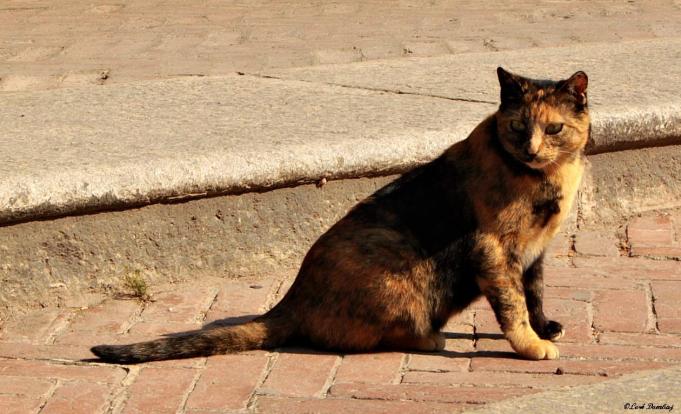
- July One Four Challenge
My July image of this cat was taken in the courtyard of Castello Sforzesco, in city of Milan, Italy. The castle was built in the 15th century by Francesco Sforza, Duke of Milan, on the remains of a 14th-century fortification. Later renovated and enlarged, in the 16th and 17th centuries it was one of the largest citadels in Europe. Extensively rebuilt by Luca Beltrami in 1891–1905, it now houses several of the city’s museums and art collections.
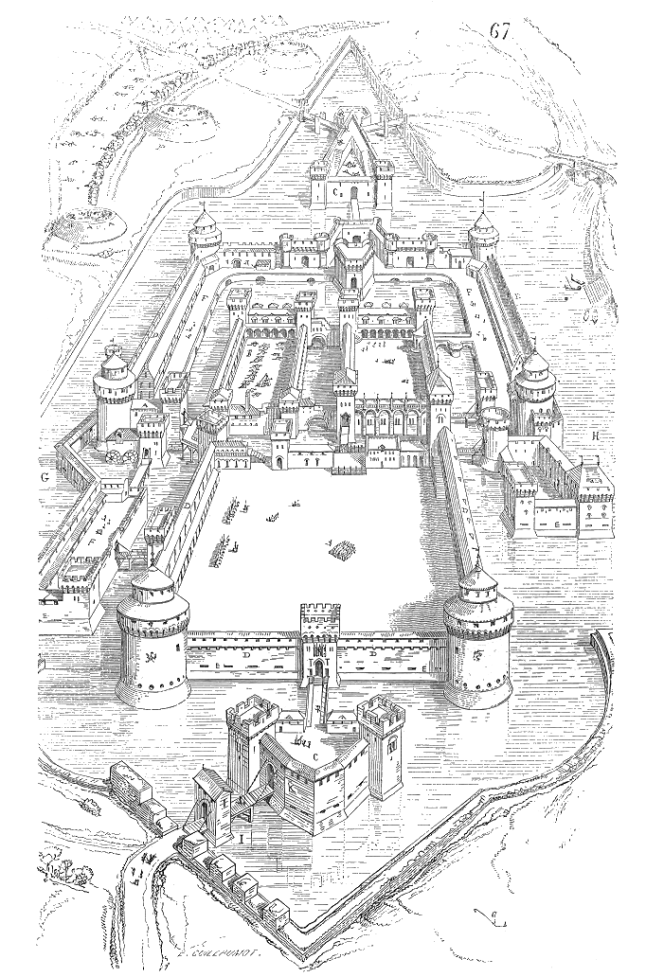
The castle in the 16th century
The original construction was ordered by local lord Galeazzo II Visconti in 1358–c. 1370. this castle was known as Castello di Porta Giova (or Porta Zubia), from the name of a gate in walls located nearby. His successors Gian Galeazzo, Giovanni Maria and Filippo Maria Visconti enlarged it, until it became a square-plan castle with 200 m-long sides, four towers at the corners and up to 7 m-thick walls. The castle was the main residence in the city of its Visconti lords, and was destroyed by the short-lived Golden Ambrosian Republic which ousted them in 1447.
In 1450, Francesco Sforza, once he shattered the republicans, began reconstruction of the castle to turn it into his princely residence. In 1452 he hired sculptor and architect Filarete to design and decorate the central tower, which is still known as Torre del Filarete. After Francesco’s death, the construction was continued by his son Galeazzo Maria, under architect Benedetto Ferrini. The decoration was executed by local painters. In 1476, during the regency of Bona of Savoy, the tower with her name was built.
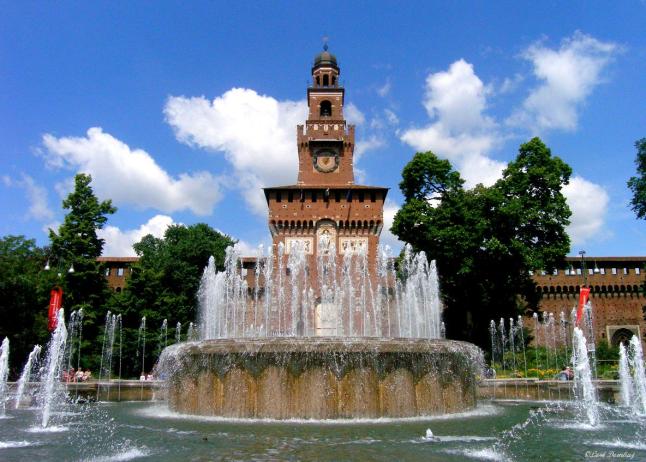
Main entrance
In 1494 Ludovico Sforza became lord of Milan, and called numerous artists to decorate the castle. These include Leonardo da Vinci (who frescoed several rooms, in collaboration with Bernardino Zenale and Bernardino Butinone) and Bramante, who painted frescoes in the Sala del Tesoro; the Sala della Balla was decorated with Francesco Sforza’s deeds. Around 1498, Leonardo worked at the ceiling of the Sala delle Asse, painting decorations of vegetable motifs. In the following years, however, the castle was damaged by assaults from Italian, French and German troops; a bastion, known as tenaglia was added, perhaps designed by Cesare Cesariano.
After the French victory in the 1515 Battle of Marignano, the defeated Maximilian Sforza, his Swiss mercenaries, and the cardinal-bishop of Sion retreated into the castle. However, King Francis I of France followed them into Milan, and his sappers placed mines under the castle’s foundations, whereupon the defenders capitulated. In 1521, in a period in which it was used as a weapons depot, the Torre del Filarete exploded. When Francesco II Sforza returned briefly to power in Milan, he had the fortress restored and enlarged, and a part of it adapted as residence for his wife, Christina of Denmark.
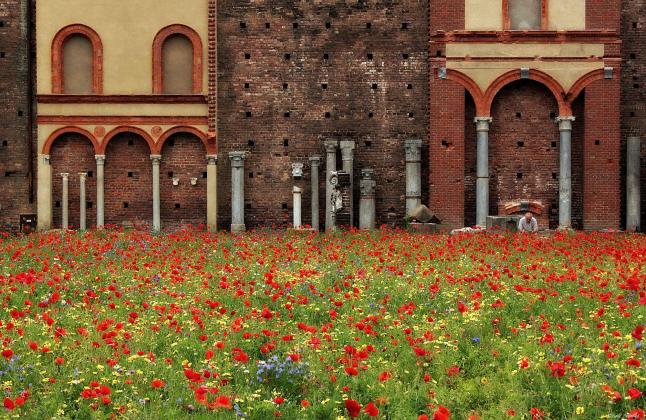
Beautiful courtyard in full bloom
Under the Spanish domination which followed, the castle became a citadel, as the governor’s seat was moved to the Ducal Palace (1535). Its garrison varied from 1,000 to 3,000 men, led by a Spanish castellan. In 1550 works began to adapt the castle to modern fortification style, as a hexagon (originally pentagon)-shaped star fort, following the addition of 12 bastions. The external fortifications reached 3 km in length and covered an area of 25.9 hectares. The castle remained in use as a fort also after the Spaniards were replaced by the Austrians in Lombardy.

- Outer castle walls
Most of the outer fortifications were demolished during the period of Napoleonic rule in Milan under the Cisalpine Republic. The semi-circular Piazza Castello was constructed around the city side of the castle, surrounded by a radial street layout of new urban blocks bounded by the Foro Buonoparte. The area on the “country” side of the castle was laid out as a vast 700m by 700m square parade ground known as Piazza d’Armi.
After the unification of Italy in the 19th century, the castle was transferred from military use to the city of Milan. Parco Sempione, one of the largest parks in the city, was created on the former parade grounds.

I have no idea what kind of flower this is
The government of Milan undertook restoration works, directed by Luca Beltrami. The Via Dante was cut through the medieval street layout in the 1880s to provide a direct promenade between the castle and the Duomo on axis with the main gate. The central tower, Torre del Filarete, above the main city entrance was rebuilt, on the basis of 16th century drawings, between 1900 and 1905, as a monument to King Umberto I.
Allied bombardment of Milan in 1943 during World War II severely damaged the castle. The post-war reconstruction of the building for museum purposes was undertaken by the BBPR architectural partnership.
Being one of the main attractions, it is swarmed with tourists. So, my goal was to show you all the quiet little spots where I spent my time collecting my thoughts. And stalking poor, unsuspecting cats.
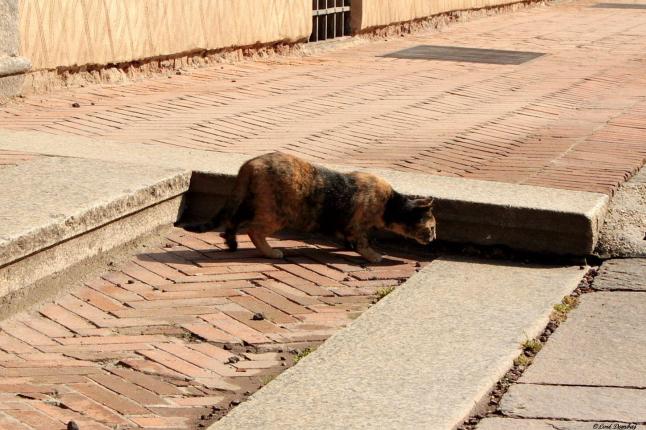
One poor unsuspecting cat
On the north side the castle opens up to Parco Sempione, a beautiful large area full of secluded spots for an afternoon rest. Once you enter the castle, it feels like you are transported years back. It is very large, but inviting place, full of hidden treasures, especially in the castle museums.
The most interesting is the Museum of Ancient Art (Civiche Raccolta d’Arte Antica), which is displayed in the ducal apartments, some of which are frescoed by Leonardo da Vinci. Included in the collection are early paleo-Christian sculptures, the superb equestrian tomb of Bernarbò Visconti and sculpted reliefs depicting Milan’s triumph over Barbarossa. The exhibit eloquently tells the story of the birth of Italy’s first city commune through murderous dynastic and regional ambitions, which made this one of the most powerful courts in Europe.
On the 1st floor the Museo dei Mobile (Furniture Museum) and Pinacoteca (Picture Gallery) blend seamlessly, leading you from ducal wardrobes and writing desks through to a collection of Lombard Gothic art. Among the masterpieces are Andrea Mantegna’s Trivulzio Madonna, Vincenzo Foppa’s St Sebastian and Bramantino’s Noli me tangere (Touch me not).
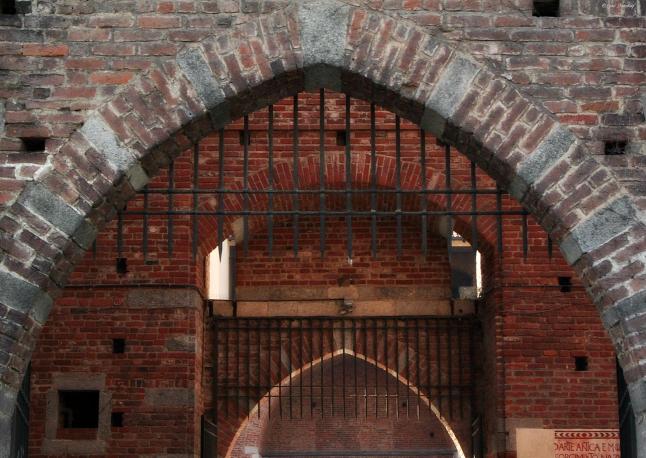
Entrance from Parco Sempione
Even after much time spent in and around castle, there is so much to explore. For me the best were the animals…cats lazily sprawled everywhere, birds hoping close without fear…I saw a reflection of history in them. Like they wanted to tell me:
Beware, lone traveler…you are standing in a place of history that came long before you and it will tell endless stories long after you are gone. And we…we are the guardians. So, take your memories and leave nothing behind.

- Guardian of the Galaxy caught in the afternoon nap

Entrance from Parco Sempione

What secrets are kept inside?

Looking up

Lost art

Standing strong

Message from aliens?

This place looks deserted

Oh, finally…people. Or rather, a man.

Flowers…because.

Where is everyone?
























I thoroughly enjoyed this tour through History of this wonderful castle. What an amazing history it has and the fact that it has been rebuilt and remodelled is also fascinating. I’m glad it’s being used today to house museums and galleries and it’s open for the public.
Love the ‘Guardians of the Galaxy’ 😃😃
This post is one I will remember. Thanks for taking the time. Love the behind the scenes approach!!
LikeLiked by 1 person
That is so nice to read, glad you liked it so much. I had to insert my funny take on life, you know me. It is so nice that people like all my different approaches to a certain subject, I love to experiment and explore.
LikeLike